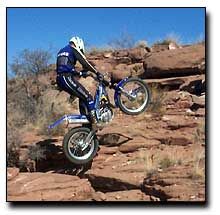|
Print Page | |||||||||||
Prominent among the travel management issues the BLM faces is the complex challenge in managing motorized activities on the public lands. The combined effect of population increases in the west, explosive growth in the use of off-highway vehicles (OHVs), and the advances in technology has generated increased social conflicts and resource impacts on the public lands related to motorized recreation and the impact on other recreation activities and resource uses.  The BLM public lands host over 55 million recreation visitors annually – an increase of over 80% since 1990. BLM estimates that 22 million of these visitors participate in motorized recreation. These include:
In compliance with Executive Orders, the BLM OHV regulations form a framework for the agency to establish management areas as either “open”, “limited”, or “closed” to off-road vehicle use. Certain BLM-managed lands also are categorized as “undesignated.”
BLM management plans do not currently address motorized access in "undesignated" areas. Thus, these "undesignated" lands have no restrictions on motorized access. The vast majority of "undesignated" areas managed by the BLM are in Alaska. For the 258 million acres of BLM administered lands, the BLM’s current OHV designation status is approximately 32% “open”, 4% “closed”, 48% “limited”, and 16% “undesignated”. Included among the “open” areas, BLM manages approximately 100 specifically designated OHV riding areas. BLM’s Comprehensive Travel & Transportation Management (CTTM) Program CTTM is the proactive management of public access and natural resources in compliance with travel-related regulations and according to the best land use management principles. It involves a comprehensive approach that considers various aspects of road and trail system planning and management, specifically natural resource management; road and trail design and maintenance; and recreation and non-recreation uses of roads and trails. Within this context, travel activities are evaluated as a means of access to public lands. They are also evaluated according to the effects all forms of motorized and non-motorized travel have on public lands and resources and on the people who use them. CTTM addresses all travel-related resource uses, such as recreational, traditional, casual, agricultural, commercial, and educational. It addresses all accompanying modes and conditions of travel as follows:
Additional information related to travel management on the public lands is available through the following links:
BLM Travel Management Program National Contacts Mark Goldbach National Trails and Travel Management Coordinator (202) 452-5176 |
||||||||||||






